In This Issue
CB World Informer Proposal To Improve 11 Meters
As we discussed in the October issue, CB is getting crowded again. Proposals of adding channels are
surfacing as they have so many times in the past. More channels are needed. But do we just want to add
channels to the existing band as a continuation of what we already have?
Remember when the FCC allotted more channels back in 1978. Before it happened many operators
unsuccessfully appealed to the FCC for sideband only channels. We had to settle for a gentlemen's
agreement. It was a nation wide effort and a remarkable one at that. Unfortunately, without one governing
body to listen to all the input and compromise for the best interest of the majority, we wound up with a
watered down agreement that changed from one area of the country to another. Some decided on lower
sideband, others upper sideband. Then when it came to what channels were AM it was all over the place.
This was OK in those areas, but when the skip was running we had every mode going on some frequencies.
This drove more operators out of band.
Back in the early days of sideband the radios were tighter. On sideband the transmitter and receiver
intermediate frequency is run through a crystal filter. The early filters allowed a frequency of between 2.4 to
2.6 KHz wide to pass through. This is common for today's Ham radios. But to cut cost on CB equipment the
manufacturers have opted to use 4 KHz filters. This widens the bandwidth of sideband transmission using
more space than necessary.
I don't know if any of you remember or new of Don Stoner. He designed and manufactured a sideband only
radio. It was a remarkable piece of technology but it didn't sell for the lack of AM. This was the cleanest
transceiver ever made for CB. Don had a proposal for CB back in the early 1980s. He proposed adding
sideband only frequencies to the CB band and spacing them 5Khz apart. In this proposal, radios that were
manufactured to cover this additional band would incorporate a compandor circuit. The compandor is a
compressor and expander unit. The transmitted signal is compressed reducing splatter caused from peak
over modulation. Then the signal is returned to its original form at the receiver when it's run through the
expander.
This was one of the best proposals I've seen. It made better use of the spectrum leaving room for further
expansion in the future. Well expansion took place, not legally and not efficiently either. With the
advancement in radio technology there are better solutions today that could be combined with Don Stoner's
idea. DSP (digital signal processing) could and should be incorporated for noise reduction. Auto clarification
or rock solid stability could also be incorporated, then everyone would want to use sideband. On the
following page you'll find illustrations of how the space is or could be used by sideband signals.
Figure 1 illustrates the space taken
by both sidebands transmitted from
radios with 4 KHz SSB filtering and
the standard 10 KHz channel
spacing. Notice the USB & LSB
overlap at center frequency. This is
the cause of splash.
Figure 4 illustrates the space taken
by 4 LSB signals from radios with
2.4KHz filtering and 5 KHz channel
spacing. There is no overlap and the
only way there would be splash is by
overdriving the signal.
Figure 3 illustrates the space taken
by 4 LSB signals from radios with 4
KHz SSB filtering and 5 KHz channel
spacing. Notice we have 4 signals in
the same amount of space with less
overlap.
Figure 2 illustrates the space taken
by both sidebands transmitted from
radios with 2.4 KHz SSB filtering and
the standard 10 KHz channel
spacing. Notice that the USB &LSB
is at a lower level of splash.
Figure 4
Figure 3
Figure 2
Figure 1
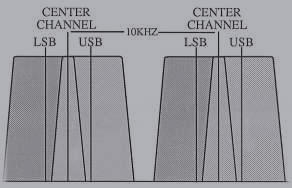
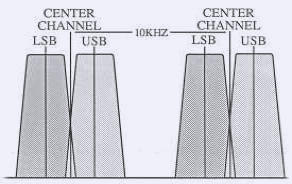
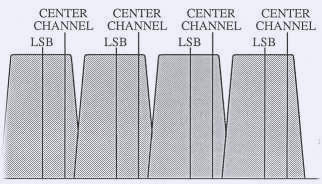
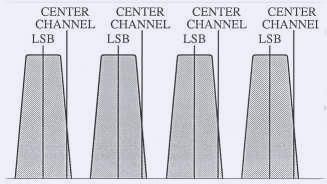
Keep in mind that AM occupies the center channel area and out as far as +/- 4Khz. AM doesn't have any
intermediate filtering. It's a hog when it comes to space. That's why adjacent channel rejection is far better
on Single Sideband than AM.
Figure I is a representation of most of today's radios. They have wide sideband filters and this is fine if you
operate 1OKhz apart and on the same sideband as everyone else. But people operate 5 down to get away
from the noise and congestion. And if their radio has two sidebands then they must get used. You can't
blame them, we've all seen the radios advertised as 120 channels even though they are 40 channel 3
mode radios, as the first two illustrations point out. Figure two demonstrates that even with 2.4Khz filtering
there is still an overlap of upper and lower sideband, although to a lesser degree. Also looking at and
visualizing another set of sideband signals placed 5Khz between the two sets already in figure 2 you'll
quickly realize that this isn't a solution either. The upper and lower sidebands of the adjacent channels
would overlap causing bleed-over.
What I propose is the elimination of one sideband. Either one, it doesn't matter they're both equally
efficient, contrary to popular belief. With 5Khz spacing we can double the usable channels. Figure 3
illustrates that one sideband with 4 KHz filtering and 5 KHz spacing is better than what we've ever had, but
it's still not good enough. We need tighter filtering. Figure 4 illustrates lower sideband only with 5 KHz
spacing and 2.4Khz filtering. This eliminates that overlap of signals. 2.6 KHz filtering would do the same.
Now I mentioned DSP earlier as a form of noise reduction. The most common is the audio type, but there
are types that work on RF frequencies. Today I don't know if it's economically feasible to incorporate the
RF type. For now let's say it's an audio type. These units take the audio signal and convert it to digital
information that a special DSP CPU (computer) analyzes looking for information that resembles voice
patterns. The information that doesn't resemble voice patterns is extracted while the voice information is
passed through to the digital to analog converter which converts the digital information back into audio.
The result is lower noise level and a more readable communication. This is much more pleasant to listen
to. A good DSP unit eliminates the need for a squelch control.
Now my proposal in full. Open up 27.415 to 27.610 and allocate this for CB lower sideband with 5Khz
spacing. It could be either upper or lower sideband, but I chose lower sideband to be consistent with the
illustrations. This would take up less than half the space used on the existing 40 channels and adds and
another group of 40 channels to the band. Any 80 channel radios manufactured would have standard 40
channels and channels 41 - 80 would be 5Khz apart lower sideband only with 2.4 - 2.6Khz IF filtering.
Some form of compandoring, DSP, and auto clarification or total stability of +/- 3OHz would be in the
specification.
These specifications may seem tough. They need to be if we want to make the best use of what's
available. As you can see we can squeeze close to another group of 80 channels out of what remains
before we reach 10-meters. Maybe all of this space above 40 should be allocated at one time giving us
close to 160 channels. I would opt for the elimination of the clarifier or only a +/- 10OHz receive only
clarifier for this new band. Most operators don't use sideband because they can't clarify properly. Some
people are tone deaf. Others are afraid of being ridiculed for improper operation. I know this is their
problem and I'm not usually one to cater to the few. Case in point, I disagree with the CPSC regulation
pertaining to CB antennas. This law punishes the majority to protect the few. If you're not smart enough to
put up an antenna, don't do it! Maybe this is why we have an increase population of idiots screwing up the
air waves, they survived the installation of their CPSC approved antenna! Now back to earth. With 5Khz
spacing where else do we need to go? We all got our clarifiers unlocked to get on frequency or drop 5Khz
... didn't we? Maybe we could try for an increase in SSB power while we're at it, say 25 Watts PEP output.
The biggest hurdle to overcome is keeping the existing equipment off the newly allocated channels. I don't
have a solution. If we had licensing and an actively funded FCC we might have a chance. One way is for
this new equipment to be so superior to the old style that everyone would want to upgrade. The two areas
of improvement that can't easily be incorporated in the old equipment are increased receiver sensitivity
and signal to noise ratio. The new radios will be quieter with the narrow sideband filters and the use of low
noise components would increase this signal to noise ratio. Also the receive audio amp should be of hifi
quality but tailored for voice range. The DSP will enhance this further making it desirable to most
operators. The price tag may be higher than conventional technology, but not as high as you might think.
And the ease of use, much quieter operation and extended range would be worth it!
Another idea would be a registration fee. The reason I suggest a registration fee is that licensing citizen's
band operators was found to be unconstitutional. But I believe that charging a registration fee or, I hate to
say it, a tax on CB radios at the manufacturing level that would go directly to enforcement could be
passed. I'm not too sure about the latter, once you open the door for taxation it's usually too easy to
increase it. The registration fee would be best. To encourage registration I would give those that register a
voice in the decision making through yearly ballots mailed as part of the renewal form.
That's it ... what do you think? Drop me a line. No calls please, I won't have time and if it's a good idea I
won't remember to publish it in a future newsletter. I'm also looking for club activities and related
announcements to publish monthly. Send to the address on the Contact page, as the FAX number will be
changing. ©
CBWI
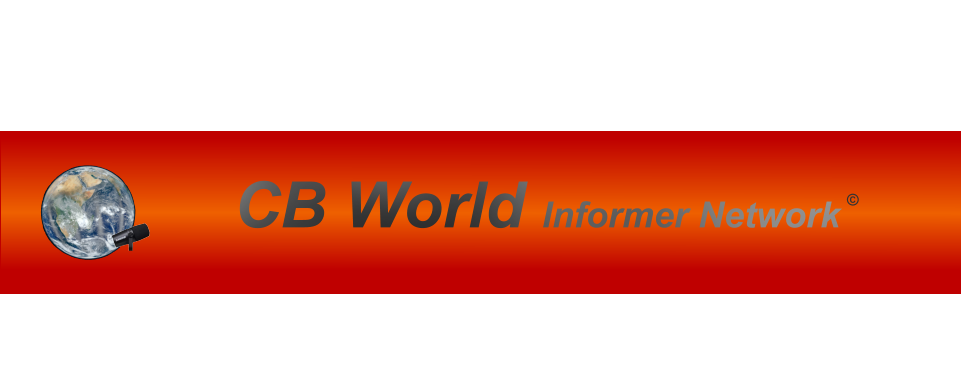
© CB World Informer Network 1996 - 2023 Worldwide Rights Reserved



AUGUST
VOLUME 1
ISSUE 4


- August 1996
- September 1996
- October 1996
- November 1996
- December 1996
- Review Of Midland 79-290 AM/SSB Mobile
- Cobra/Uniden SSB Chassis Mod UPDATE
- Clarifiers
- President Jackson Unlocked Clarifier Mod.
- Cobra 148 & Uniden GrantXL Clarifier Mod.
- Cobra 142GTL & Uniden Washington Clarifier
- Uniden Grant Unlocked Clarifier Mod.
- Uniden PCI22 PRO SSB Clarifier Mod.
- Review Of The Northstar DX880HL
- Big Bust At The Consumer Electronics Show
- Bob's CB Has Opened
- January 1997
- The New Mongoose Model 450 Review
- Wilson Antenna Tests The Trucker 5000
- A Company With Interference Solutions
- Solving Telephone RF Interference
- Lowpass Filters: What, Where, And How
- Using Highpass Filters For TVI
- How To Conduct A Noise Audit
- Modern Do-It-Yourself Grounding Techniques
- Using Water Pipes For RF Grounding
- Using Water Pipes For RF Grounding
- February 1997
- The New Emperor TS-3010 Review
- Bulkhead Grounding
- Grounding Coaxial Cable Shields
- Using Anti-Oxidants
- Modern Lightning Protection - RF Entry Ports
- Modern Lightning Protection - AC Power Lines
- Modern Lightning Protection - Control Lines
- Modern Lightning Arrestors - Polyphaser VS I.C.E.
- Modern Lightning Arrestors - Alpha Delta VS I.C.E.
- Modern Lightning Arrestors - Cushcraft VS I.C.E.


- July 2001
- Galaxy DX 2547 Reveiw
- Inside The DX 2547
- DX 2547 Channel Mod
- DX 2547 Clarifier Mod
- DX 2547 Photos
- DX 2547 Manual Excerpts
- The Anttron Story
- Anttron 305 Revisited
- New Antrron Products
- Aries A-SWR 460 Digital Meter
- Barjan Buys Wilson Antenna
- Wilson Electronic In Cell Phone Market
- First Web Issue
- Help Get The Word Out
- August 2001
- Sneak Preview: The New Maverick A24
- Maverick A24 Front Panel Controls
- Maverick Conversion
- Inside The Magnum Maverick A24
- Barjan Buys Francis Antenna
- Wilson Antenna, 1 Year After Barjan Buyout
- CBer Busted
- Astaic's MobileMax
- Solarcon I-Max 2000
- False Performance Claims
- CAUTION: Don't Burn Out That Radio
- Magnum's Filtered Power Cord
- Dragon Super Heavy Duty SO-239 Stud
- CBWI...Give Us Your Opinion
- September 2001
- Reveiw Of The RCI 2950DX
- RCI 2950DX Image Rejection Modification
- RCI 2950DX Coversion & Clarifier Mods
- RCI 2950DX Photos
- RCI 2950DX Board Component Layout
- RCI 2950DX Adjustment Layout
- RM-9807: Petition To Remove 155 Mile Limit
- Slip-Seat Radio Box
- RF Limited UTB-1 Adjustable Talkback Board
- A Message From The Editor
- October 2001
- November 2001
- December 2001
- January 2002
- February 2002
- July 2002
- June 2014



























